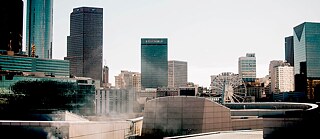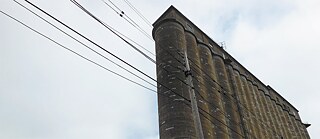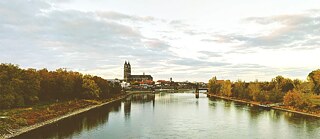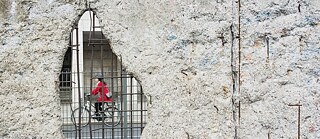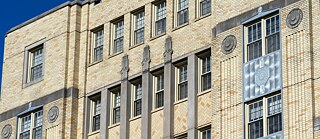48 Buildings in the Southside
Revitalizing Downtown Atlanta
When Jake Nawrocki had the idea of reviving the Southside of Atlanta’s downtown neighborhood — which could take up to 20 years — he had to find investors interested in a long-term commitment.
Listen to this episode: Apple Music | Spotify | Download
This episode is by Susanna Capelouto. Susanna is a senior editor at Atlanta’s NPR station WABE where she works with reporters covering everything from health to urban affairs. Before joining WABE in 2017, Susanna worked for CNN. In this podcast, Susanna talks to city planners, historians, investors, and residents of the Southside of Atlanta. The music “Banjo Basic Man” comes from Lobo Loco and is under a CC BY-NC-ND 4.0 license.
Transcript
Susanna Capelouto: Hi. My name is Susanna Capelouto, and I want to take you to the oldest part of the city of Atlanta. It’s an area littered with boarded-up buildings and sad empty streets. It’s just South of downtown ... and the perfect setting for a zombie movie.
Jake Nawrocki: Looks like they’re filming a movie here on Broad Street. We’ve had tremendous interaction with the movie industry.
Susanna Capelouto: I meet Jake Nawrocki on Broad Street. His company owns the empty building where a film crew is busy setting up for a shoot.
Jake Nawrocki: They’re sort of taking the liberty of using this as a movie set from time to time. But it’s a great thing for us because it activates the street.
Susanna Capelouto: There aren’t many people here now, but some German investors are working with Jake to change that ... more on that later. First, you have to understand the history of this part of Atlanta. Some of the facades behind the boarded-up storefronts date back to a time after the Civil War when Atlanta emerged from being burned to the ground. This neighborhood was right next to the railroad station, says Tim Crimmins. He’s an Atlanta historian.
Tim Crimmins: It developed as a commercial district in the immediate aftermath of the Civil War. If you took a look around that area, you would see stores along Broad. Then White House Street — now Peachtree Street Southwest — and you would see developing industries along the railroad to the North and to the West. And in the course of the 19th century, that entire area built right up.
Susanna Capelouto: But by the 1960s ... desegregation, white flight, the rise of the suburbs, and shopping malls had sapped the life out of South Downtown. And now, Jake Nawrocki wants to revive it. He shows me how as we look at one of the buildings.
Jake Nawrocki: And while it’s not exactly appealing visually today, it’s actually a good thing in a lot of ways, because it really preserved the bricks and windows behind. So, if you were to go inside this building — around the back, inside — you’d see all these original windows are still there. All the original window frames. In fact, these windows here still have the letters that the original tenant in there — Bird’s shoe store — written on these giant windows. This is an area of Atlanta that I’ve been driving through and mapping and coming down here for years before. And I had a strong fascination with this idea in this neighborhood long ago.
Susanna Capelouto: His idea is simple: Renovate all the old buildings and bring back stores and people. But who would buy 48 old buildings in need of major upgrades on like, eight city blocks?
Olaf Kunkat: Jake Nawrocki put me to South Downtown and I immediately discovered the beauty of this former heart of the city.
Susanna Capelouto: Bring in Olaf Kunkat, a real estate investor from Berlin. His company, Newport Holdings, was ready to expand to the United States, and Olaf remembers touring the South Downtown neighborhood ... when he saw Atlanta’s new Mercedes Benz Stadium down the road.
Olaf Kunkat: And I said to Jake: Look, let’s count the minutes it needs to walk over to the stadium — and it was just eight minutes. And we arrived at the stadium and I said: Look I mean, if we would be in Europe, this would be definitely the heart of the city because everything is here you need. And along with this beautiful grid of streets and the assembly of beautiful old buildings. I thought: I think this is a great chance.
Susanna Capelouto: Olaf was not afraid to tackle old buildings and bring them back to life. It’s what got his business started nearly 25 years ago.
[BERLIN WALL FALLS IN ABC NEWS BLIP]
Susanna Capelouto: In 1989, Peter Jennings reported on the fall of the Berlin Wall. The years that followed brought opportunity to East Berlin — and the city center where the wall once stood.
Olaf Kunkat: East Berlin in the early ’90s was just a forgotten part of the former capital of Germany. So East Berlin, in the district of Mitte — buildings were really empty. So I was young, it was 1993 ... I started my first investment. And we also looked: This is all beautiful, it is ruined, it just needs some love. And you can bring back this part of the city back to a beautiful life — and so we did.
Susanna Capelouto: But looking back, Olaf is not really happy with what has become of his early investments.
Olaf Kunkat: The first time it was great because we just covered this part of Mitte in Berlin after a while it went to be so popular that all big chains moved in and rents increased and apartment rents increased. And today it’s not any longer affordable for just ordinary people to live there. And when I spoke to Jake in Atlanta, I said: Look, this is one thing we definitely have to avoid. So when we start investing here, our main approach is to keep it as highly mixed-use and make it affordable for any income class, as long as we can.
Susanna Capelouto: As long as they can. Atlanta does not have rent control or other ways to ensure housing costs don’t skyrocket, but the city does give tax incentives to investors who build affordable units. And once Jake’s company starts building apartments, it’s something they plan to do. Back on Broad Street, Jake explains his affordable concept for retail stores like this.
Jake Nawrocki: ‘Placemaking’ is sort of the buzzword. And what happens is, sometimes you lose that grittiness that kind of makes it feel interesting. And so we’re intentionally not designing with a heavy hand. It’s just a piece of the city that we’re bringing back to life. So, we want to flower shop. I would like to be able to offer a daily coffee that’s not crazy expensive, but I’d also like people to be able to buy a five-dollar cappuccino if they want to. We need fast-casual food. Hopefully, that's healthy. We also need fine dining, right?
Susanna Capelouto: For the few people who already live here, the renovations can’t start fast enough.
Deshanna Dottrey: Hello. My name is Deshanna Dottrey, and I’ve lived in this area since March 2011.
Susanna Capelouto: I meet Deshanna in the rooftop garden of Kessler city lofts. It’s a former department store that was turned into loft apartments. From up here, you can see airplanes take off and land to the South at the Atlanta airport. Coca Cola’s world headquarters, CNN, and the gold dome of the State capitol round out the spectacular view.
Deshanna Dottrey: I never knew how much I wanted to live downtown until I lived downtown.
Susanna Capelouto: But she’s also had to compromise. There aren’t many amenities in the city blocks around her home.
Deshanna Dottrey: This is kind of, like, the last bastion of uninhabited retail commercial space ... the south of Marietta, is what I’m referring to. We have to travel to other neighborhoods to get groceries.
Susanna Capelouto: She has high hopes for her neighborhood though and is following Jake’s plans for the area.
Deshanna Dottrey: I’m definitely watching what’s going to happen. I’m hoping that they’re going to make it cool. I’m hoping that they’re going to make it usable.
Susanna Capelouto: That’s also the hope of her neighbor, Denise Majit. She’s lived at the Kessler Lofts for five years. She says crime still keeps people away from South Downtown.
Denise Majit: I mean, there is crime down here like there is in every place else in Atlanta. But there’s a perception that there’s a lot more along this particular strip — Broad, Peachtree, MLK.
Susanna Capelouto: She wants more police in the area because for years she has seen her share of petty crimes around the empty streets.
Denise Majit: We see it all. Prostitution. We see indecent exposure. We see drug addicts. We see all that. And until Newport goes in there, and lights the streets and lights the storefronts ... and more and more people are moving into the apartments that they’re planning, and that type of thing — we won’t get the coverage that we should be getting now, but don’t get.
Susanna Capelouto: Right now, the revival of eight dormant city blocks into a walkable fun neighborhood is just an idea with a 300 million dollar investment. There’s no guarantee when — or if — enough people will move here, or that businesses will occupy the beautiful old stores again. But Jake is working with Germans here and knows they’re in it for the long haul ... unlike American real estate investors.
Jake Nawrocki: It is a deep topic, but the whole style in which real estate is developed and financed in the U.S. seems to be entirely different in some ways than in Europe.
Susanna Capelouto: Different, he says, because U.S. real estate investment funds have other goals.
Jake Nawrocki: Those funds are robust. They have a lot of money to invest but they ... we are also good, in America, putting things in very clear boxes, you know — investment types and categories. So this investment is this kind of thing and this investment that kind of thing that there’s no overlap. The outcome of that is that the typical American investor would say: If I can’t get in and out of this in five years, it’s probably not for me. Whereas, on average, the European mindset is longer. They would like to build this. Achieve those returns, then keep it, because they understand that assets like this are irreplaceable.
Susanna Capelouto: His partner Olaf is banking on a global trend of people moving into cities where they can walk and bike and don’t need cars ... and making that a reality in South Downtown Atlanta takes time.
Olaf Kunkat: It’s absolutely a long-term investment. If you are not starting such investment with this approach, you better should do something else. Because developing such kind of a city takes, I would say, at least 10 to 20 years to bring it back to its full beauty.
Susanna Capelouto: The eight blocks will be developed in phases, not all at once. About 100,000 new people move to the Atlanta area each year, so why shouldn’t some of them come live here? Jake says he’s not catering to a target market or a type of resident. He just wants South Downtown to become a diverse place.
Jake Nawrocki: We’re trying to offer as many different things down here to attract as many different slices of the population as possible. And not say this is only for XYZ consumer group.
Susanna Capelouto: Any playgrounds?
Jake Nawrocki: We’ve had internal discussions of how long will it take for families to live in South Downtown — we believe it will happen. And at some point, we’ll have a playground. That would be a dream come true if we could get to a point where there are children playing on a playground in South Downtown.
[NAT SOUND DOWNTOWN]
Susanna Capelouto: Maybe someday, with the help of some German investors. For THE BIG POND. I’m Susanna Capelouto in Atlanta.



